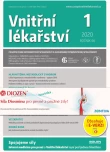Difficulties in the Diagnosis of Cardiac Amyloidosis and Treatment Options: Case Report
Authors:
Renáta Závodná 1; Kamil Zeman 1; Martin Pleva 2; Milan Kamínek 3
Authors‘ workplace:
Interní oddělení Nemocnice ve Frýdku-Místku
1; Oddělení intervenční radiologie, Magnetická rezonanceKomplexního kardiovaskulárního centra, Nemocnice Podlesí, Třinec
2; Klinika nukleární medicíny LF UP a FN Olomouc
3
Published in:
Vnitř Lék 2020; 66(1): 71-77
Category:
Case Report
Overview
Amyloidosis is a disease characterized by extracellular deposition of amyloid, an insoluble pathological protein. Clinical manifestation is based on the type of amyloid, and to define the specific type of amyloid is crucial to determining prognosis and optimal therapy. Echocardiography may be the first method to highlight the diagnosis of cardiac amyloidosis, but this is not a specific method. Typical echocardiographic findings in cardiac amyloidosis are myocardial enlargement, atrial dilatation, decreased longitudinal contraction with relatively long preserved systolic function of the left ventricle and left ventricular diastolic dysfunction with restrictive type of filling. Magnetic resonance gives a somewhat specific image of late gadolinium enhancement, but cannot distinguish individual types of amyloid. The biopsy can be falsely negative. In recent years, methods of nuclear medicine have become more important, especially in case of the transthyretin form of amyloidosis. Our case report shows a 72-year-old male, in whom 99mTc-DPD scintigraphy revealed the senile form of transthyretin amyloidosis. The therapeutic possibilities of transthyretin form of cardiac amyloidosis are currently being explored.
Keywords:
Biopsy – scintigraphy – magnetic resonance – echocardiography – Amyloidosis – doxycycline – tauroursodeoxycholic acid – 99mTc-Diphosphono-Propanodicarboxylic Acid
Sources
1. Glaudemans A, Slart R, Zeebregts C, et al. Nuclear imaging in cardiac amyloidosis. Eur J Nucl Med Mol Imaging 2009; 36 : 702–714.
2. Pinney J., Whelan C, Petrie A, et al. Senile Systemic Amyloidosis: Clinical features at presentation and outcome, J Am Heart Assoc. 2013; 2: e000098. .
3. Donnely J, Hanna M. Cardiac amyloidosis: An update on diagnosis and treatment, Cleveland clinic Journal of Medicine 2017; 84(suppl. 3): 12–26.
4. Halatchev I, Zheng J, et al. Wild-type transthyretin cardiac amyloidosis, previsouly known as senile cardiac amyloidosis: clinical presentation, diagnosis, management and emerging therapis. J Thorac Dis 2018; 10 : 2034–2045.
5. Palladini G, Russo P, Bosoni T, et al. Identification of amyloidogenic light chains requires the combination of serum-free light chain assay with immunofixation of serum and urine. Clinical chemistry 2009; 55 : 3.
6. Kumar S, Dispenzieri A, Lacy M, et al. Revised prognostic staging system for light chain amyloidosis incorporating cardiac biomarkers and serum free light chain measurements, J Clin Oncol 2012; 30 : 989–995
7. Vogelsberg H, Mahrholdt H, Deluigi C, et al. Cardiovascular Magnetic Resonance in Clinically Suspected Cardiac Amyloidosis. J Am Coll Cardiol 2008; 51 : 1022–1030.
8. Castano A, Drachman B, Judge D, et al. Natural history and therapy of TTR-cardiac amyloidosis: emerging disease-modifying therapis from organ transplantation to stabilizier and silencer drugs. Heart Fail Rev 2015; 20 : 163–178.
9. Ng B, Connors LH, Davidoff R, et al. Senile systemic amyloidosis presenting with heart failure: a comparison with light chainassociated amyloidosis. Arch Intern Med 2005; 165 : 1425–1429.
10. Pinney J, Whelan C, Petrie A, et al. Senile Systemic Amyloidosis: Clinical features at presentation and outcome. J Am Heart Assoc 2013; 2: e000098.
11. Ruberg FL. et al. Prospective evaluation of the morbidity and mortality of wild-type and V122I mutant transthyretin amyloid cardiomyopathy: the transthyretin amyloidosis cardiac study (TRACS). Am Heart J 2012; 164 : 222–228.
12. Perugini E, Guidalotti PL, Salvi F, et al. Noninvasive etiologic diagnosis of cardiac amyloidosis using 99mTc-3,3-diphosphono-1,2-propanodicarboxylicacid scintigraphy. J Am Coll Cardiol 2005; 46 : 1076–1084.
13. Javier de Haro-del Moral F, Sánchez-Lajusticia A, Gómez-Bueno M, et al. Role of cardiac scintigraphy with 99mTc-DPD in the differentiation of cardiac amyloidosis subtype. Rev Esp Cardiol 2012; 65 : 440–446.
14. Kristen AV, et al. Prophylactic implantation of cardioverter-defibrillator in patients with severe cardiac amyloidosis and high risk for sudden cardiac death. Heart Rhythm 2008; 5 : 235–240.
15. Obici L, et al. Doxycycline plus tauroursodeoxycholic acid for transthyretin amyloidosis: a phase II study. Amyloid 2012; 19(Suppl. 1): 34–36.
16. Hutchison CA, Plant T, Drayson M, et al. Serum free light chain measurement aids the diagnosis of myeloma in patients with severe renal failure. BMC Nephrology. Dostupné z DOI: .
17. Pleva M, Borová J, Plevová I, et al. Význam zobrazení srdce pomocí magnetické rezonance v diagnostice hypertrofické kardiomyopatie, část II. Vnitř Lék 2017; 63 : 249–253.
18. Mathew S, Maurer MD, Jeffrey H, et al. Tafamidis Treatment for Patients with Transthyretin Amyloid Cardiomyopathy. N Engl J Med 2018; 379 : 1007–1016.
19. Flodrova P, Flodr P, Pika T, et al. Cardiac amyloidosis: from clinical suspicion to morphological diagnosis. Pathology (Sydney) 2018; 50 : 261–268.
20. Aiglová R, Táborský M, Lazárová M, et al. Srdeční transthyretinová amyloidóza – častější, než jsme si mysleli? Cor et Vasa 2017; 59 : 476.
21. Pika T, Heřmanová Z, Flodrová P, et al. Laboratorní aspekty systémové AA amyloidózy. Klinická biochemie a metabolismus 2017; 25 : 56–58.
22. Kováčik F, Táborský M, Hutyra M, et al. Srdeční amyloidóza – kazuistika. Intervenční a akutní kardiologie 2016; 15 : 145–147.
23. Kufová Z, Pika T, Jelínek T, et al. Hereditární amyloidózy – etiologie, klinický obraz a léčba. Transfuze a hematologie dnes 2015; 21 : 184–192.
Labels
Diabetology Endocrinology Internal medicineArticle was published in
Internal Medicine

2020 Issue 1
Most read in this issue
- Sarcopenic obesity – current view
- Chronic stress, mental discomfort, and depression increase the rates of infectious, autoimmune as well as malignant diseases
- Odešel velký člověk a lékař prof. MUDr. Vítězslav Kolek, DrSc., FCCP
- Autoimmune hepatitis
